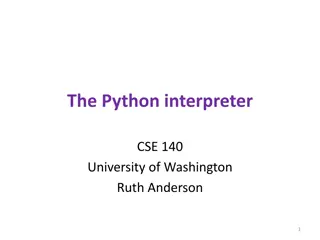Understanding Python ML Tools: NumPy and SciPy
Python is a powerful language for machine learning, but it can be slow for numerical computations. NumPy and SciPy are essential packages for working with matrices efficiently in Python. NumPy supports features crucial for machine learning, such as fast numerical computations and high-level math functions. SciPy builds on NumPy, adding additional mathematical functions and support for sparse arrays. With NumPy and SciPy, you can manipulate structured lists of numbers, vectors, matrices, images, tensors, and even convolutional neural networks.
Download Presentation

Please find below an Image/Link to download the presentation.
The content on the website is provided AS IS for your information and personal use only. It may not be sold, licensed, or shared on other websites without obtaining consent from the author. Download presentation by click this link. If you encounter any issues during the download, it is possible that the publisher has removed the file from their server.
E N D
Presentation Transcript
Python ML Tools
Motivation Python is a great language, but slow compared to Java, C, and many others Python packages are available to represent and operate on matrices We ll briefly review numpy and scipy You need some familiarity to be able to create or access datasets for training, evaluation and results
What is Numpy? NumPy supports features needed for ML Typed multi-dimentional arrays (matrices) Fast numerical computations (matrix math) High-level math functions Python does numerical computations slowly 1000 x 1000 matrix multiply Python triple loop takes > 10 min. Numpy takes ~0.03 seconds
NumPy Arrays Can Represent Structured lists of numbers Vectors Matrices Images Tensors Convolutional Neural Networks ?? ?? ?? ?11 ??1 ?1? ???
NumPy Arrays Can Represent Structured lists of numbers Vectors Matrices Images Tensors Convolutional Neural Networks
NumPy Arrays Can Represent Structured lists of numbers Vectors Matrices Images Tensors Convolutional Neural Networks
NumPy Arrays, Basic Properties import numpy as np a = np.array([[1,2,3],[4,5,6]],dtype=np.float32) print a.ndim, a.shape, a.dtype 1. Arrays can have any number of dimensions, including zero (a scalar). 2. Arrays are typed: np.uint8, np.int64, np.float32, np.float64 3. Arrays are dense. Each element of the array exists and has the same type.
NumPy Array Indexing, Slicing x[0,0] x[0,-1] x[0,:] x[:,0] # first column (many entries) # top-left element # first row, last column # first row (many entries) Notes: Zero-indexing Multi-dimensional indices are comma-separated (i.e., a tuple)
SciPy SciPy builds on the NumPy array object Adds additional mathemaiical functions and sparse arrays Sparse array is one where most elements = 0 An efficient representation only explicitly encode the non-zero values Access to a missing element returns 0
SciPy Sparse Array Use Case (1) NumPy and SciPy arrays are numeric We can represent a document s content by an vector of features Each feature is a possible word A feature s value is: TF: number of times it occurs in the document; TF-IDF: normalized by how common the word is And maybe normalized by document length
SciPy Sparse Array Use Case (2) We may be interested only in the 50,000 most frequent words found in a large document collection and ignore others We assign each English word a number The sentence the dog chased the cat Would be a numPy vector of length 50,000 Or a sciPy sparse vector of length 4 A 800 words news article may only have 100 unique words; The Hobbit has about 8,000























